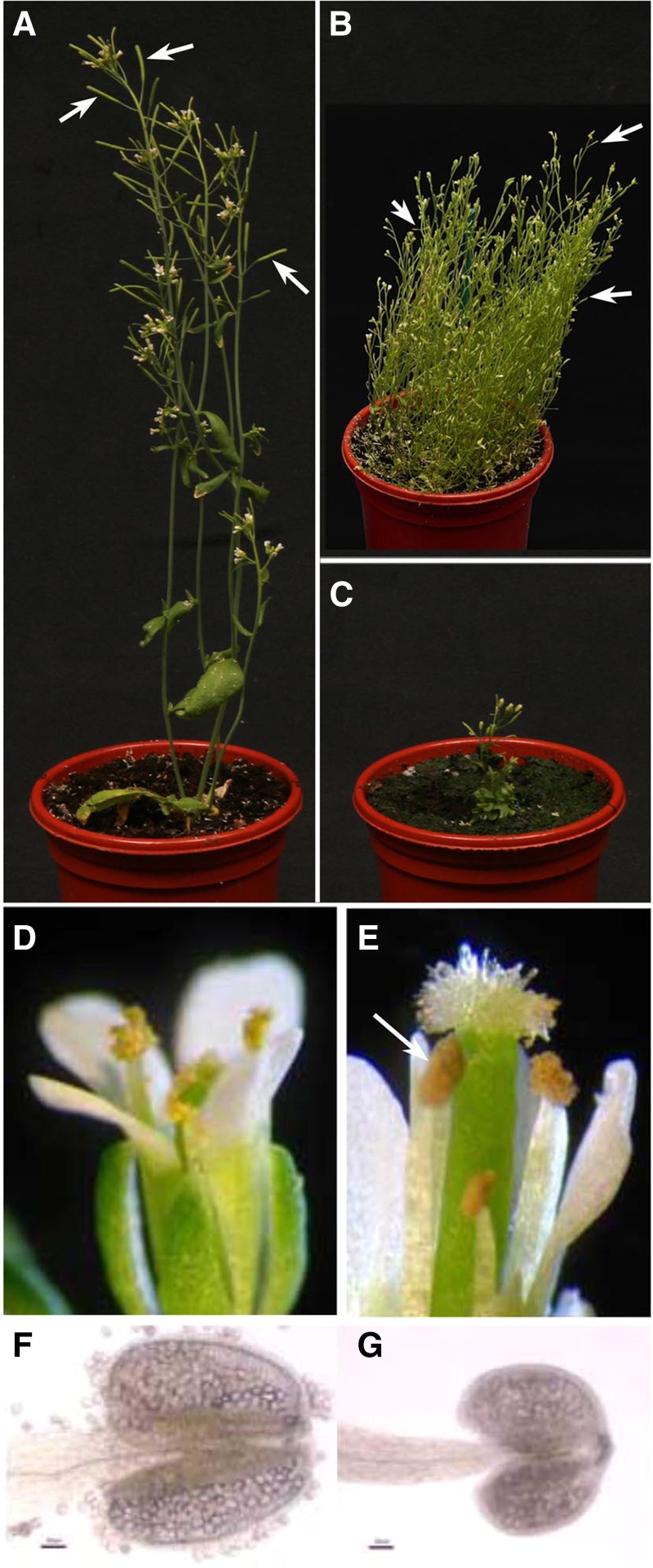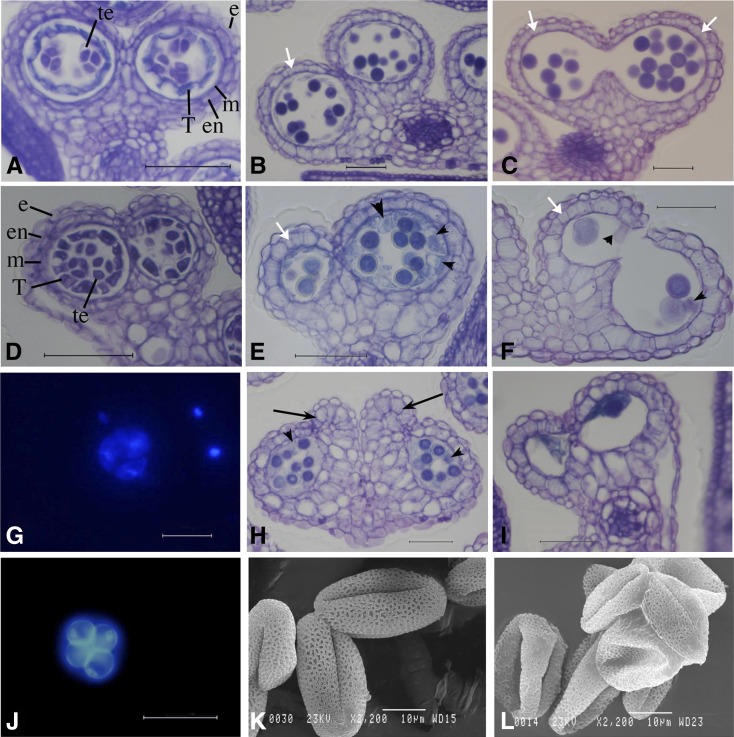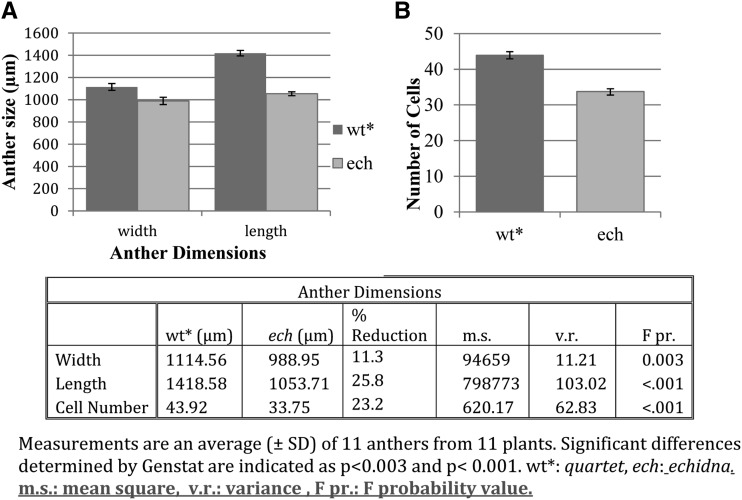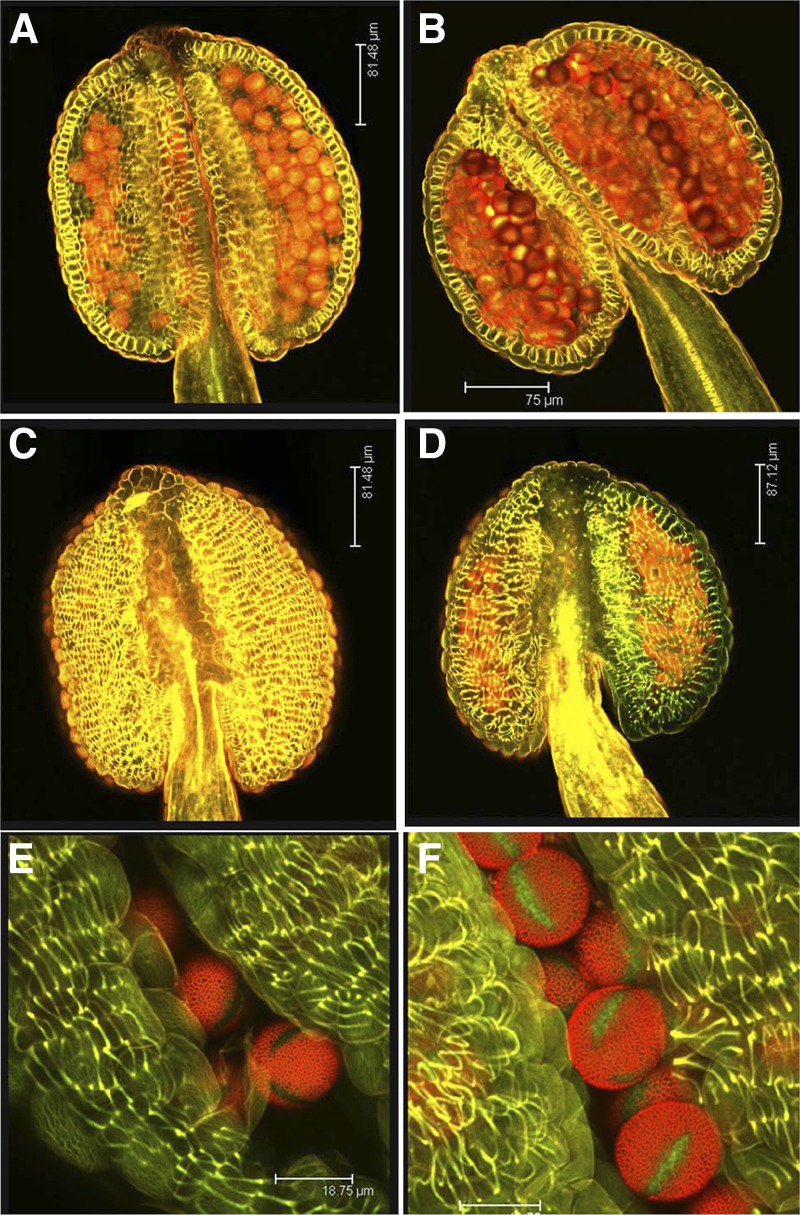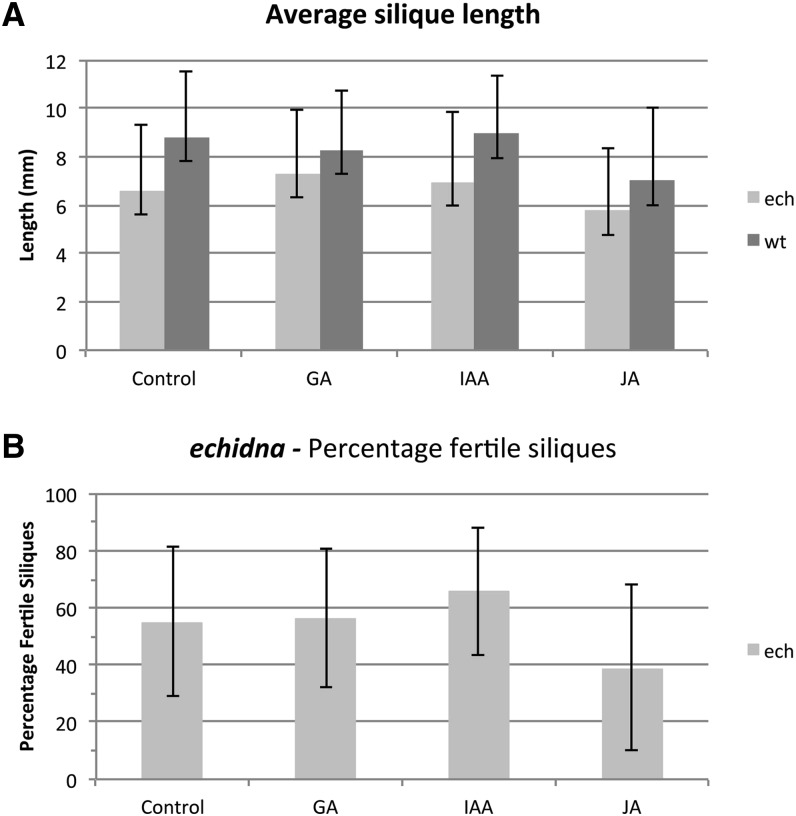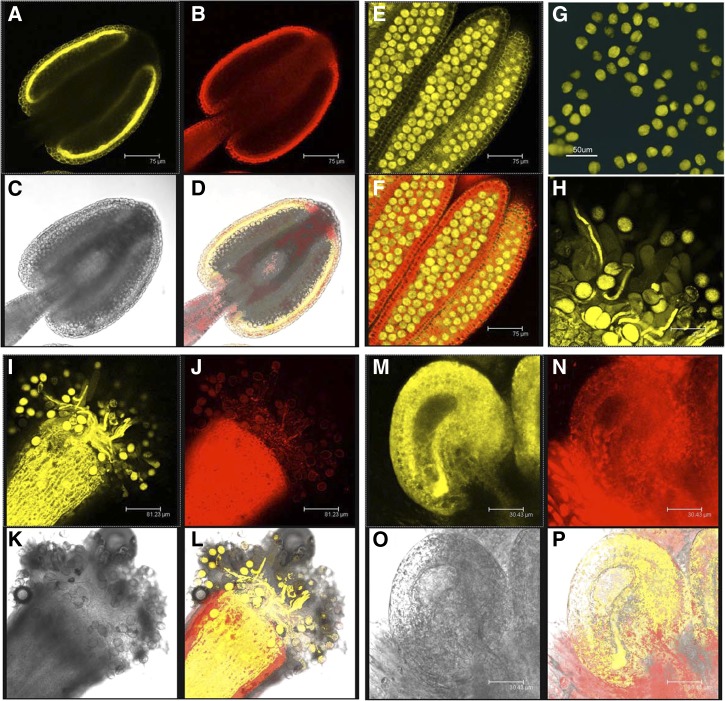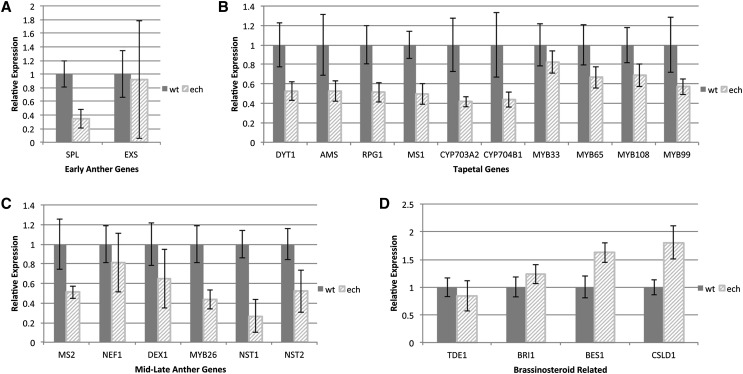ECHIDNA-mediated trans-Golgi network trafficking is needed for full male fertility in Arabidopsis and is required for anther and pollen formation, filament elongation, and anther dehiscence in addition to pollen tube formation.
Abstract
The trans-Golgi network (TGN) plays a central role in cellular secretion and has been implicated in sorting cargo destined for the plasma membrane. Previously, the Arabidopsis (Arabidopsis thaliana) echidna (ech) mutant was shown to exhibit a dwarf phenotype due to impaired cell expansion. However, ech also has a previously uncharacterized phenotype of reduced male fertility. This semisterility is due to decreased anther size and reduced amounts of pollen but also to decreased pollen viability, impaired anther opening, and pollen tube growth. An ECH translational fusion (ECHPro:ECH-YELLOW FLUORESCENT PROTEIN) revealed developmentally regulated tissue-specific expression, with expression in the tapetum during early anther development and microspore release and subsequent expression in the pollen, pollen tube, and stylar tissues. Pollen viability and production, along with germination and pollen tube growth, were all impaired. The ech anther endothecium secondary wall thickening also appeared reduced and disorganized, resulting in incomplete anther opening. This did not appear to be due to anther secondary thickening regulatory genes but perhaps to altered secretion of wall materials through the TGN as a consequence of the absence of the ECH protein. ECH expression is critical for a variety of aspects of male reproduction, including the production of functional pollen grains, their effective release, germination, and tube formation. These stages of pollen development are fundamentally influenced by TGN trafficking of hormones and wall components. Overall, this suggests that the fertility defect is multifaceted, with the TGN trafficking playing a significant role in the process of both pollen formation and subsequent fertilization.
Pollen production and release is a critical stage in plant development that typically involves gene expression from over half of the genome. The extent of genomic involvement in pollen development is illustrated by the high frequency of mutations that result in a failure of male fertility; these can be a consequence of the failure of pollen development or pollen release, dehiscence. Detailed analysis of male-sterile mutants in Arabidopsis (Arabidopsis thaliana) and rice (Oryza sativa) has improved the basic understanding of pollen and anther development (Scott et al., 2004; Ma, 2005; Wilson and Zhang, 2009; Cui et al., 2012); however, there are multiple aspects of pollen formation that are still unclear, and many defects result in uncharacterized effects of reduced fertility or complete sterility.
The ECHIDNA (ECH) gene was initially identified from expression profiling of the vascular cambium in poplar (Populus spp.) and associated with secondary xylem formation (Hertzberg et al., 2001). The Arabidopsis ech mutant was shown to have a bushy stature with defects in root and hypocotyl elongation, which was linked to defective cell expansion and elongation (Gendre et al., 2011). Analysis of roots in the ech mutant and complementation analyses in yeast showed that the ECH protein impacts on cell expansion by mediating trans-Golgi network (TGN) secretory trafficking but does not affect endocytosis (Gendre et al., 2011). However, in addition to the defects associated with plant stature, the ech mutant also displays a previously unreported phenotype of reduced fertility.
Pollen development occurs in a specialized organ, the stamen, which comprises anthers that hold the developing pollen supported by a filament containing the vasculature connections. Stamen primordia arise from divisions in the L1, L2, and L3 layers in the floral meristem. Divisions in the L2 layer result in four clusters of archesporial cells that subsequently form the central sporogenous cells, which are surrounded by four maternal cell layers: the tapetum, middle cell layer, endothecium, and outer epidermis (Scott et al., 2004). The structure of the maternal anther cell layers has been shown to be critical for the production and release of functional pollen, as demonstrated in a number of male-sterile mutants, which have defects in cell division and early stages of differentiation of the tapetum and sporogenous cells. For example, mutants of the Leu-rich repeat receptor kinase EXTRA SPOROGENOUS CELLS (EXS)/EXCESS MICROSPOROCYTES1 (Canales et al., 2002; Zhao et al., 2002) and its ligand TAPETAL DETERMINANT1 (Jia et al., 2008) result in sterility due to the formation of additional male sporocytes and a lack of tapetal cells.
The tapetum has been shown to be critical for functional pollen formation, with many of the characterized male-sterile mutants exhibiting abnormal tapetal development, including DYSFUNCTIONAL TAPETUM1 (DYT1; Zhang et al., 2006; Zhu et al., 2008), TAPETAL DEVELOPMENT AND FUNCTION1 (TDF1; Zhu et al., 2008), ABORTED MICROSPORES (AMS; Sorensen et al., 2003; Xu et al., 2010), and MALE STERILITY1 (MS1; Wilson et al., 2001; Ito and Shinozaki, 2002). After differentiation, the tapetum layer becomes metabolically highly active and plays an essential role in the biosynthesis and secretion of sporopollenin and other wall materials for the developing pollen, prior to breakdown via programmed cell death (Ariizumi and Toriyama, 2011). A frequently observed phenotype in male-sterile mutants is enlarged tapetal cells that show defects in secretion and subsequent alterations in programmed cell death breakdown (Wilson and Zhang, 2009). This indicates the important role that the tapetum plays in the regulation of pollen development and, in particular, the passage of materials to the central locule for viable pollen production.
Male-sterile phenotypes have also been identified due to a failure of pollen release, dehiscence. Secondary thickening occurs specifically in the endothecium layer of the anther; this layer and the presence of selective thickening within it are critical to generate the differential forces that are required for anther dehiscence and pollen release (Wilson et al., 2011; Nelson et al., 2012). The importance of this secondary thickening is demonstrated in the myb26 mutant (Yang et al., 2007) and in the double NAC SECONDARY WALL THICKENING PROMOTING FACTOR1 NAC SECONDARY WALL THICKENING PROMOTING FACTOR2 (nst1 nst2) mutant (Mitsuda et al., 2005), which lack endothecium thickening and, as a result, fail to dehisce (Nelson et al., 2012).
Previous investigations of the ech mutation indicated that it is impaired in TGN secretion, resulting in dwarf plants with defects in root and hypocotyl cell elongation. The ech mutant also has an uncharacterized phenotype of impaired male fertility; therefore, a detailed analysis of reproduction in the ech mutant was conducted. ECH expression was seen in the anther tapetum during the early stages of tapetal development and microspore release but was subsequently detected in the pollen, pollen tube, and stylar tissues. The reduced fertility was linked to decreased anther size and pollen production but also to reductions in pollen viability, anther opening, and pollen tube growth. The anther wall thickening was reduced and disorganized in ech, possibly as a consequence of altered secretion of wall materials through the TGN. The male-sterile myb26 mutant has defects in anther endothecium wall thickening resulting in a failure of dehiscence; the ech myb26 double mutant exhibits the phenotypes of both mutants and fails to produce secondary thickening, indicating that the ECH-mediated pathway is acting independently of or upstream through MYB26, possibly by providing the components required for secondary cell wall thickening. The reduction in male fertility, therefore, is likely to be a consequence of multiple effects due to altered secretion in the anther because of impaired TGN transport in the ech mutant; the resulting defects are associated with tapetum and pollen wall development but also anther dehiscence and pollen tube formation.
RESULTS
ech Mutants Are Dwarf and Highly Branched and Show Reduced Fertility
The homozygous ech mutant, as reported previously (Gendre et al., 2011), has a dwarf phenotype with a high level of branching. However, the ech mutant also exhibited significantly reduced fertility, although some normal silique elongation and seed set still occurred, particularly late in development (Fig. 1). The ech mutant is from the SAIL mutant population (Sessions et al., 2002), which was generated in the quartet (qrt) mutant background. The qrt mutation affects polygalacturase breakdown after pollen mother cell meiosis and thus enables tetrad analysis to be conducted; however, there is no overall effect on fertility (Preuss et al., 1994). Thus, the phenotype of incomplete tetrad separation in the ech qrt double mutant is likely to be due to the presence of the qrt mutation, while the reduction in fertility is likely to be principally associated with the lack of ECH expression and not due to the effect of the qrt mutation. Flowers from the ech mutant had a normal external morphology with the typical organ number, except that the sepals were slightly paler green than the wild type. The reduction of fertility was associated with male reproduction, since emasculated ech flowers had full seed set when pollinated with wild-type pollen, indicating that female fertility was not significantly affected. Early stamen filament development appeared to be generally normal; however, although filament extension occurred, this was reduced compared with the wild type; thus, at full maturity, the anthers did not completely reach the top of the pistil (Fig. 1, D and E). The ech anthers also had a slightly distorted shape and were significantly smaller than the wild type. Pollen was visible in the ech anthers; however, anther dehiscence was also impaired, with some anthers failing to dehisce while others only partially opened, with the pollen remaining predominantly inside (Fig. 1, D–G).
Figure 1.
Phenotypic analysis of floral development in the ech mutant. A, Wild-type plant showing silique development (arrows) and full fertility. B and C, ech mutant showing increased branching, stunted growth, and reduced fertility, as indicated by reduced elongation of siliques (arrows). D, Wild-type flower showing complete dehiscence and pollen release. E, ech mutant flower showing reduced filament elongation and partial dehiscence (arrow) with associated reduced pollen release. F, Mature wild-type anther with abundant viable pollen, some of which has already been released from the anther. G, Mature ech anther, which is stunted and reduced in size, containing pollen that has reduced viability and limited release. Bars = 50 µm.
Pollen and Anther Development Is Impaired in ech Mutants
The ech anthers were smaller and slightly malformed, with a squat shape and individual locules that failed to develop; however, some viable pollen was present (Figs. 1 and 2). The early stages of ech anther and pollen formation appeared generally normal, with the anthers developing the correct number of cell layers and pollen mother cell meiosis commencing as in the wild type (Fig. 2, A and D); however, by the later stages of pollen formation, a high proportion of pollen degeneration had occurred (Fig. 2, E, F, H, and I) compared with the wild type (Fig. 2, B and C). This could be seen as small, misshapen, or broken microspores and immature pollen in sectioned material or as inviable pollen by Alexander staining of fresh anthers. Frequently in ech, individual anther locules failed to develop, resulting in the anthers having an abnormal, malformed shape (Fig. 2H; Supplemental Fig. S1). During stages 10 and 11 of anther development (Sanders et al., 2005), at the initiation of tapetal degeneration and pollen mitosis I, the tapetum and anther wall tissues in ech showed dense staining with toluidine blue, with high levels of material in the locule and tapetal tissues (Fig. 2, E and H); this may reflect pollen wall materials that are not being secreted correctly or are accumulating in the anther locule in the ech mutant. In the corresponding stage in the wild type, the tapetum was beginning to break down and much lower amounts of materials were seen, presumably due to their correct secretion for normal pollen development (Fig. 2B). As pollen development proceeded, large amounts of abnormal material could be observed in the ech locule associated with degeneration of the tapetum (Fig. 2, E and I), followed by subsequent degeneration of some of the pollen. The ech anther appeared highly constricted, with very prominent secondary thickening in the endothecium layer (Fig. 2, E and F, white arrows), compared with the wild type (Fig. 2, B and C). Varying levels of severity of impaired pollen development were observed, with some ech anthers showing limited pollen degeneration (Fig. 2, E and F) while others failed to develop normal locules (Fig. 2H, arrows) or had completely degenerated pollen (Fig. 2I).
Figure 2.
Anther and pollen development in the ech mutant. A to C show the wild type, D and E show the mild ech mutant anther phenotype, and H and I show the severe ech mutant anther phenotype. A and D, Tetrad stage. B, E, and H, Tapetal degradation and microspore maturation. C, F, and I, Dehiscence. The early stages of pollen development, specification of cell layers and tetrad formation, and microspore release occurred normally in the ech mutant (D). However, post meiosis, abnormal tapetal development (E and H; arrowheads) and inviable pollen (F; arrowheads) and degeneration (I) were seen in ech. The secondary thickening that developed in the endothecium tissues (white arrows) appeared to be reduced and disorganized in ech (E, F, H, and I) compared with the wild type (B and C). Different levels of severity of phenotype were observed in the ech mutant; the most severe cases had completely malformed anther locules (H; arrows) and total pollen degeneration (I). G and J, DAPI-stained tetrads indicating the chromosomes and meiotic progression. J, Wild-type (qrt) pollen, showing typical incomplete separation of the tetraspores, as seen in the qrt background, but normal chromosome staining and meiotic progression. G, ech tetrads, showing incomplete microspore release associated with the qrt mutation but also occasional collapsed microspores with a lack of chromosomal staining. K, Wild-type (qrt) pollen with regular wall formation. L, ech pollen, showing some collapsed pollen. e, Epidermis; en, endothecium; m, middle cell layer; T, tapetum; te, tetrad. Bars = 50 µm (A–J) and 10 µm (K and L).
Nuclear 4′,6-diamino-phenylindole (DAPI) staining indicated that both the wild type and the ech mutant initiated meiosis and tetrad development; however, in ech, abnormal nuclei were seen in the tetrads, with diffuse staining of nuclear material suggesting nuclear degeneration and in severe cases collapse of microspores (Fig. 2, G and J). The ech mutant was generated in the qrt1-1 mutant background, in which the microspores fail to separate and the products of single meiotic events are kept together throughout pollen development (Preuss et al., 1994). This allows the nature of the fertility defect, whether gametophytic and/or sporophytic, to be determined (Johnson-Brousseau and McCormick, 2004). Pollen was examined from anthers of open wild-type (qrt) and ech flowers. Viability staining (Alexander, 1969) revealed that almost all of the wild-type (qrt) pollen tetrads contained four viable pollen grains (84.5%; Table I). A lower number of pollen tetrads were observed in the ech mutant, and these had a much higher frequency of abortion (Table I). Only 18% of the ech pollen tetrads contained four viable pollen grains, while 24% and 18% had one and two dead pollen grains, respectively. Most had three inviable pollen grains (34%); however, a very few (6%) showed completely degenerated pollen (Table I). This frequency of abortion does not equate to the typical 50% abortion seen in gametophytic defects, suggesting that the ech defect is sporophytic in nature; this was further confirmed by the 3:1 segregation of the ech phenotype and as previously shown by segregation of the vegetative phenotype (Gendre et al., 2011).
Table I. Pollen viability in the ech mutant.
Tetrad analysis is shown for pollen mother cell meiotic products in the wild type (qrt) and ech. In the qrt background, the tetraspores fail to separate, enabling the viability of the meiotic products to be determined (Preuss et al., 1994). [See online article for color version of this table.]
| Plant | Amount of Viable Pollen in Tetrads Containing Multiples of |
Total No. | ||||
|---|---|---|---|---|---|---|
| 4 | 3 | 2 | 1 | 0 | ||
| % (n) | ||||||
| Wild type | 84.5 (98) | 11.2 (13) | 4.3 (5) | 0 (0) | 0 (0) | 116 |
| ech | 18.0 (9) | 24.0 (12) | 18.0 (9) | 34.0 (17) | 6.0 (3) | 50 |
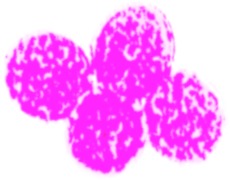 |
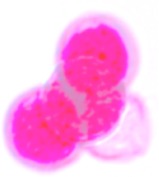 |
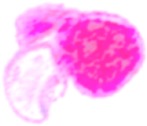 |
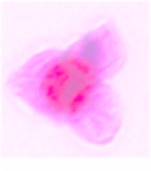 |
|||
The ech mutant produced a reduced amount of mature pollen; however, some of this was viable, as indicated by Alexander viability staining and by the ability of the plants to self-fertilize and produce some seed. In vitro germination analysis indicated that ech pollen germination was much reduced compared with the wild type, with only 1% of the ech pollen able to germinate compared with 37% in the wild type (Table II). The length of the ech pollen tube was also reduced by approximately 20% compared with the wild type (Table II). Despite the reduced quantity of viable ech pollen and its impaired rate of germination, a low level of self-fertilization was seen, with subsequent seed set indicating that some of the pollen is evidently functional in planta. Scanning electron microscopy analysis showed that the surface of ech pollen was irregular compared with the wild type (qrt) and frequently collapsed, although the overall exine patterning appeared relatively normal (Fig. 2, K and L).
Table II. Pollen germination rates and tube growth in the ech mutant.
Pollen germination rates and pollen tube growth are shown for the wild type (qrt) and ech. Columns 1 and 2 for pollen germination refer to independent biological repeats
| Plant | Pollen Germination |
Average Germination | Pollen Tube Length | |
|---|---|---|---|---|
| 1 | 2 | |||
| % | mm | |||
| Wild type | 36.9 | 37.2 | 37.0 | 0.22 ± 0.12 |
| ech | 0.53 | 2.0 | 1.0 | 0.16 ± 0.09 |
ech Anthers Have Reduced Cell Division and Expansion with Altered Secondary Thickening
The length and width of the ech anthers were significantly reduced, on average by 25.8% and 11.3%, respectively (Fig. 3), compared with the wild type. Cell numbers in the anther were analyzed to determine the nature of this reduced size; the numbers of endothecium cells were counted from transverse sections taken prior to dehiscence of the anthers. There was a 23.2% reduction in endothecial cell number in ech anthers (Fig. 3). Although cells were counted at dehiscence, this reduction in cell number was clearly evident in the ech anther sections from the tetrad stage (stage 7) onward (Fig. 2, B and E). These data suggest that the reduction in anther size may be due to reduced levels of cell division as well as cell expansion.
Figure 3.
Comparison of anther size in the ech mutant and the wild type (wt). A, Average longitudinal and transverse diameters of wild-type (qrt) and ech anthers. B, Average numbers of endothecium cells in anther transverse sections from wild-type (qrt) and ech anthers.
Lignocellulosic secondary thickening in the anther endothecium is an essential requirement for dehiscence and pollen release and, thus, is vital for male fertility. By pollen mitosis (stage 11), both the wild type and the ech mutant showed endothecium expansion and the development of secondary thickening in the normal cell layers; however, this appeared perturbed in ech (Fig. 2, B and E). The anther secondary thickening was analyzed by confocal microscopy using acridine orange/ethidium bromide stain, which differentially stain cellulose and lignin (Yang et al., 2007). As discussed previously, the ech endothecium had decreased numbers of cells compared with the wild type, with reduced cell expansion. The ech endothecium cells showed abnormal secondary thickening patterning, which was reduced and disorganized as compared with the wild type (Fig. 4, A–D). When analyzed under equivalent intensity of excitation light and gain to the wild type, the ech mutant showed significantly less signal, suggesting a corresponding reduction in cell wall biosynthesis/altered composition of the anther cell wall (Supplemental Fig. S2). Normal stomium and septum development was seen, with lysis of the septum occurring apparently normally (Fig. 4, E and F). Nonetheless, dehiscence in the ech mutant was frequently incomplete and less effective than in the wild type (Fig. 1, D and E); this may be a consequence of the smaller endothecium cells with decreased amounts of irregular, disorganized secondary thickening that restrict anther opening.
Figure 4.
Anther endothecium cells and secondary thickening in the ech mutant. A, C, and E, Wild type (qrt) anthers. B, D, and F, ech mutant anthers. Anthers stained with ethidium bromide/acridine orange and visualized by confocal microscopy (ethidium bromide stains lignified cells [red fluorescence; 514-nm excitation; emission collection at 590 nm] and the acridine orange stains lignified and nonlignified walls [green fluorescence; 488-nm excitation; emission collection at 520 nm] and merged images are shown. A and B, Confocal sections through an anther showing thickening in the endothecium layer. C and D, Abaxial surface of an anther. E and F, Anther opening. The ech mutant exhibited decreased and disorganized thickening in the endothecium (B and D) and partial anther dehiscence (F). Bars = 81.5 µm (A and C), 75 µm (B), 87.1 µm (D), and 18.8 µm (E and F).
Fertility in ech Was Not Rescued by Exogenous Applications of GA, Auxin, or Jasmonic Acid
In ech mutants, male fertility is reduced in part due to pollen degeneration but also due to inefficient pollen release and pollination, with the ech mutant filament significantly shorter than the wild type (Fig. 1, D and E). Our observations prompted us to investigate whether these defects might be due to hormonal concentration effects during reproductive development in the ech mutant. The ech mutant is known to have impaired TGN trafficking, possibly affecting brassinosteroid (BR) movement (Gendre et al., 2011), and has recently been shown to affect trafficking of the auxin influx carrier AUX1 (Boutté et al., 2013). Previous work has shown the significance of hormones during plant reproduction; auxin has been shown to have a major effect on secondary thickening and anther development (Nagpal et al., 2005; Cecchetti et al., 2008, 2013), GA on male fertility (Plackett et al., 2011, 2012), and jasmonic acid (JA) on filament extension (Ishiguro et al., 2001). In separate studies, male-sterile mutants associated with hormone deficiencies have been overcome by hormone applications (Wilson and Zhang, 2009). Therefore, the effects of supplementing the ech mutant flowers with exogenous auxin, GA, and JA were evaluated. Plants were sprayed with hormones once the plants were in full flowering and three flowers had formed; this was repeated after a further 4 d. Male-sterile mutants typically have small, short siliques due to the failure of silique extension as a result of a lack of seed set. A quantitative assessment of fertility was made by measuring the length of four siliques per plant, while checking also that seed formation was absent/reduced and corresponded to the silique elongation, and also by assessing the total number of fully developed seed-containing siliques per plant. In all cases, silique length and associated seed development were reduced in the ech mutant as compared with the wild type, although a high level of variation was observed in silique length and the percentage of fertile siliques. The hormone treatments did not appear to have any significant effect upon fertility or on the level of variation in the fertility observed (Fig. 5); seeds generated in the partially elongated siliques were fertile and used to maintain the line in further generations.
Figure 5.
Effects of applications of GA, auxin, or JA on silique seed set in the ech mutant. A, Average silique length. B, Percentage of fertile siliques in ech after hormone treatment. IAA, Indole-3-acetic acid; wt, wild type.
ECH Is Differentially Expressed within the Developing Anther, Pollen, and Pollen Tubes
ECH expression was analyzed during anther and pollen development using the ECHPro:ECH-YELLOW FLUORESCENT PROTEIN (YFP) line that had been developed by Gendre et al. (2011); developmentally regulated expression was seen in the anther, pollen, and stigmatic tissues. ECH expression was initially detected in the tapetal tissue of the anther during the free microspore stage (pollen mitosis I-pollen mitosis II; Fig. 6, A–D). However, after tapetal degeneration, expression was only detected in the developing microspores and not in the maternal anther cells (Fig. 6, E and F). Expression was subsequently observed in the free pollen, developing pollen tubes, and stylar tissues (Fig. 6, G–L) and also in the ovule integuments (Fig. 6, M–P).
Figure 6.
Expression of ECH in floral organs, as indicated by tissue-specific expression of an ECHPro:ECH-YFP construct. A to D, Anther during the free microspore stage (pollen mitosis I-pollen mitosis II). E and F, Anther after tapetal degradation, prior to dehiscence. G, Mature pollen. H, Mature pollen on stigma, forming pollen tubes. I to L, Mature stigma and stylar tissue showing pollen germination and tube growth. M to P, Ovule. A, E, G, H, I, and M show the 497-nm excitation filter, exhibiting YFP expression. B, J, and N show the 560-nm excitation filter, exhibiting chlorophyll autofluorescence. D, F, L, and P show superimposed YFP and chlorophyll autofluorescence. C, K, and O show bright-field images. ECHPro:ECH-YFP expression is seen in the tapetal tissue of the anther (A and D) during pollen mitosis I to pollen mitosis II, but no expression was seen in the free microspores. However, after tapetal degradation during pollen mitosis II, ECHPro:ECH-YFP expression was no longer seen in the anther but was detected in the immature pollen grains (E and F). This expression was maintained in the mature pollen grains after dehiscence (G and H), during pollination on the stigmatic surface (H, I, and L), and in the pollen tube during subsequent growth (H, I, and L). Expression was also seen in the stylar tissues (I and L) and in the ovule integuments (P). Bars = 75 µm (A–F), 50 µm (G), 42.4 µm (H), 81.2 µm (I–L), and 30.4 µm (M–P).
The ech Mutant Shows Reduced Expression of Genes Associated with Anther Development
RNA was isolated from closed buds from the wild type and the ech mutant and used to determine the expression by quantitative reverse transcription (RT)-PCR of key genes previously linked to pollen development and anther dehiscence. These genes included those associated with anther cell specification (SPOROCYTELESS [SPL] and EXS), tapetal development (DYT1, RUPTURED POLLEN GRAIN1 [RPG1], MYB33, MYB65, MYB108, and MYB99), genes involved in anther cuticle and pollen wall development (AMS, MS1, CYTOCHROME P450 [CYP703A2 and CYP704B1], DEFECTIVE IN EXINE PATTERNING1 [DEX1], MS2, and NO EXINE FORMATION1 [NEF1]), and those linked to endothecium secondary thickening and anther dehiscence (MYB26, NST1, and NST2). ECH had been previously linked to the TGN and the passage of materials destined for the plasma membrane (Gendre et al., 2011) and specifically implicated in the sorting of cargo destined for the plasma membrane or secretion, including the BR receptor kinase BRASSINOSTEROID INSENSITIVE1 (BRI1; Gendre et al., 2011), and more recently the movement of pectin and xyloglucan through the TGN (Gendre et al., 2013) and the auxin influx carrier AUX1 (Boutté et al., 2013). Therefore, the expression of genes associated with the BR pathway (TRANSIENT DEFECTIVE EXINE1 [TDE1], BRI1-EMS SUPRESSOR1 [BES1], and CELLULOSE SYNTHASE-LIKE D1 [CSLD1]), including the receptor kinase BRI1, was also investigated.
The expression of all the genes tested that are known to be associated with the regulation of pollen development was down-regulated in ech buds (Fig. 7, A–C). Expression still occurred, however, in most cases but was reduced by about 50%, which may be a reflection of the smaller anthers and impaired development of the pollen in the ech mutant. Genes associated with the regulation of anther secondary thickening, particularly MYB26 and NST1, showed a more pronounced down-regulation (Fig. 7C), which may be an indication of the altered level of secondary thickening observed in the ech mutant endothecium. This suggests that ech is generally affecting multiple, key aspects of pollen and anther formation, which are associated with tapetal and endothecium function, as well as pollen wall development.
Figure 7.
Quantitative RT-PCR expression analysis shows the down-regulation of key genes associated with pollen development in the ech mutant. A, Early genes involved in establishing anther cell layers. B, Tapetum-specific genes involved in pollen wall formation. C, Mid- to late-anther-expressed genes. D, BR and cellulase synthase genes. wt, Wild type.
BRs have been shown to regulate a number of key genes involved in pollen development, including SPL/NOZZLE, TDF1, AMS, MS1, and MS2 (Ye et al., 2010), and also to be involved in xylem differentiation (Yamamoto et al., 2007). TDE1 has also been associated with BR biosynthesis and pollen exine formation (Ariizumi et al., 2008). The expression analysis of the BR-related genes showed varied results, with BRI1 and TDE1 showing no significant changes in expression in ech buds; however, BES1 was enhanced in ech (Fig. 7D). CSLD1 has high sequence similarity to CESA proteins and is thought to be involved in cellulose synthesis during pollen tube growth (Wang et al., 2011). The ech buds showed enhanced expression of CSLD1, which may reflect the alteration of cellulose synthesis during pollen development and pollen tube growth, possibly due to the reorganization of wall biosynthesis as a consequence of altered TGN trafficking.
ECH Affects Secondary Thickening in the Endothecium But Is Not Directly Associated with the Regulation of Secondary Thickening by MYB26
The ech mutant showed reduced endothecium cell size and number, altered endothecium thickening, and abnormal dehiscence. Since the MYB26 transcription factor regulates anther endothecium cell expansion and secondary thickening (Yang et al., 2007), the relationship between these two genes was investigated. The ECHPro:ECH-YFP construct was introduced into the myb26 background to determine whether MYB26 had any effect on ECH expression. The plants were selected based upon their sterility and confirmed by PCR genotyping. Confocal microscopy indicated that ECH expression was not significantly affected by the myb26 mutation (Supplemental Fig. S3). The ECHPro:ECH-YFP construct showed a similar pattern of expression to that seen in the wild-type background, with expression observed in the tapetum during the free microspore stage (pollen mitosis I-pollen mitosis II), in the pollen grains after tapetal degeneration, and then in the developing pollen tubes and the ovule integuments (Supplemental Fig. S3).
Abnormal secondary thickening was observed in the ech mutant; therefore, a double mutant was generated between myb26 and ech to determine the relationship between the two genes. The double mutant had the phenotype of both mutants, with male sterility, reduced stature, and highly branched growth habit; ECH expression appeared normal in the myb26 mutant (Supplemental Fig. S3). The disorganized secondary thickening observed in ech was not apparent in the double mutant ech myb26, which showed the complete male sterility due to a lack of endothecial thickening and an associated failure of dehiscence, as seen in the single myb26 mutant. This suggests that the effects on secondary thickening associated with ECH are upstream of the MYB26 secondary thickening pathway. Therefore, it is likely that there is no direct connection between the ECH and MYB26 pathways in their effects on anther development, and in particular secondary thickening, despite the down-regulation of MYB26 expression in the ech background (Fig. 7); however, the lack of thickening in the double mutant indicates that ECH acts upstream of MYB26, possibly by providing pectin and hemicellulose molecules to the plasma membrane for secondary thickening in the anther.
DISCUSSION
ech Shows Reduced Male Fertility Due to Defects in Pollen Formation and Release and Pollen Tube Growth
The reductions in fertility observed in the ech mutant were principally associated with defects in male reproduction, with female fertility proceeding normally. A number of phenotypic changes were observed that all impacted on effective male gamete production and fertilization, including reduced pollen production, due to impaired development during and post meiosis, shorter stamen filaments, impaired dehiscence, and reduced pollen germination/tube growth. The ech anthers were significantly smaller than the wild type, due to a decrease in cell number and also reduced expansion of these cells. The decrease in anther cell number was particularly evident in the endothecium and epidermal cell layers from the tetrad stage onward. Previously, analysis of vegetative growth in the ech mutant indicated that the reduction of growth was linked to decreased cell elongation (Gendre et al., 2011); however, it may be that there was also an associated reduction of cell number that contributed to the overall dwarf phenotype. Anther dehiscence was delayed compared with the wild type, and the filament length in the ech mutant was reduced, resulting in dehiscence occurring below the pistil rather than at the same level, as in the wild type. Similar effects had been reported previously in JA (e.g. dde1 [Sanders et al., 2000] and dad1 [Ishiguro et al., 2001]) and GA mutants (Plackett et al., 2011). However, the defects in ech fertility could not be rescued by treatment with the hormones indole-3-acetic acid, GA, and JA. In addition to the smaller cell size in ech anthers, there was also frequent abortion of some locules and malformed anther structure. Similar aberrations have been observed in the DELLA and GA mutants, which suggests that alteration of the anther hormone levels may impact upon the synchrony between the anther locules.
ECH has been identified previously as a conserved component of the TGN that is functioning in root and hypocotyl tissues and that is associated with the delivery of cell wall components, such as xylans and pectins, to the plasma membrane (Gendre et al., 2011, 2013). The observed effects on anther development are consistent with the impaired delivery of cell wall components; however, given the range of phenotypic changes and the importance of hormones during anther development, it may also be that localized hormone levels are affected in the anther as a consequence of the impaired TGN trafficking and that this is impacting on male reproduction.
An overall reduction in microspore and pollen formation was observed in ech; initiation of pollen meiosis appeared to be normal, although fewer initial tetrads were seen and degeneration of the meiotic products in the tetrads was observed, yet some functional pollen was seen, as indicated by self-fertilized seed set (Fig. 2). This suggests a degree of redundancy in TGN trafficking in the anther and pollen, which is ensuring sufficient trafficking for a threshold of materials to accumulate that enables some pollen development to occur. Defects in pollen tube growth due to defective trafficking of components to the pollen tube tip have been reported previously. For example, CSLD1 and CSLD4 are targeted to the Golgi apparatus and transported to the plasma membrane to participate in cellulose deposition at the tip of the growing pollen tube; mutations in both genes cause a significant reduction in cellulose deposition and the organization of pollen tube wall layers (Wang et al., 2011). Glycosyltransferases have also been linked to pollen tube growth, with defects in the production of the Golgi-localized MALE GAMETOPHYTE DEFECTIVE4, which encodes a rhamnogalacturonan II xylosyltransferase, resulting in impaired rhamnogalacturonan II synthesis and defective pollen tube and root growth (Liu et al., 2011). The oscillatory increase in growth in lily (Lilium longiflorum) pollen tubes has also been shown to correlate with exocytosis and the increase of wall materials in the growing tube (McKenna et al., 2009). Therefore, the reduced rate of pollen germination and tube growth seen in ech is likely to be due, at least in part, to the defective TGN, possibly associated with pectin trafficking, during pollen tube growth.
Pollen Wall Production Occurs in ech
Genes linked to pollen development showed down-regulation in ech; this was seen in genes associated with the early events in anther differentiation but also those related to wall deposition, anther dehiscence, pollen maturation, dehiscence, and pollen tube germination (Fig. 7) and may be partly due to the impaired development of the anther and abnormal breakdown of the tapetum, resulting in a reduction of gene expression. This is a common phenotype seen in many male-sterile mutants, particularly those associated with biosynthesis and secretion of the pollen wall materials (Vizcay-Barrena and Wilson, 2006; Zhang et al., 2006, 2008; Xu et al., 2010). Nevertheless, some viable pollen was formed, although this pollen was less effective in germination and pollen tube growth. The mature ech pollen exine and sporopollenin patterning appeared normal (Fig. 2, K and L); however, the pollen was frequently collapsed and nonfunctional, indicating defective wall composition. ECH has been linked previously to controlling the balance between secretory trafficking and vacuolar targeting (Gendre et al., 2011) and in particular pectin and xyloglucan transport (Gendre et al., 2013). CSDL1 is a member of the cellulose synthase superfamily that has been shown to have a role in pollen tube growth (Wang et al., 2011); CSDL1 expression was significantly increased in the ech mutant. This altered expression may reflect a compensation mechanism that is acting to increase cellulose biosynthesis during pollen development in the absence of normal TGN-mediated trafficking of pectin and other cell wall components. These data suggest that Golgi trafficking is key to the pollen wall synthesis and formation process; however, the formation of some functional pollen indicates that there is at least partial redundancy in the TGN trafficking to enable limited fertility to be maintained.
Altered TGN Trafficking in the ech Mutant Significantly Affects Male Reproduction
ECH has been localized to the TGN, with the ech mutant exhibiting defective secretory trafficking but normal endocytosis, with a similar phenotype observed by blocking vacuolar H+-ATPases by concanamycin A treatment (Gendre et al., 2011). The TGN trafficking pathway has been associated with the transport of cargo from the Golgi to the plasma membrane; these have typically been defined by the secreted GFP but include BRI1 and cell wall components like xyloglucans and pectin. Therefore, it was speculated that hormone transport might also be affected in the ech mutant. A number of hormones have been linked previously both to pollen production and dehiscence; auxin has been key for the production of early events in anther development and also the initiation of secondary thickening processes (Cecchetti et al., 2008, 2013). BRs have been shown to control many aspects of gene expression associated with pollen formation (Ye et al., 2010). A number of mutants in the BR pathway have been identified; these generally exhibit dwarfed stature and frequently have fertility defects, and often a dark green appearance, which was not observed in ech. Most of the severe BR mutants show a reduction in pollen viability, partly due to a reduction in cell elongation and an associated short anther filament (Azpiroz et al., 1998), although the BR biosynthetic mutant constitutive photomorphogenesis and dwarfism had been linked previously to defects in pollen tube growth (Szekeres et al., 1996); however, this was not seen in a subsequent analysis (Ye et al., 2010). BES1, a key transcription factor associated with BR signaling, has been shown to directly regulate a number of genes linked to pollen formation (SPL/NOZZLE, TDF1, MS2, MYB103, MS1, and At3g23770; Ye et al., 2010); however, these genes still showed some expression in the ech buds, suggesting that the defect in ech is reducing gene expression within the anther but that this is not a complete block with sufficient development to enable partial fertility to be maintained. The BR mutants also showed distinctive enlargement and vacuolation of the tapetal cells (Ye et al., 2010); this was not observed in ech, which suggests that although the BR pathway may be affected, it is unlikely to be the principal factor affecting male reproduction in ech. Rescue of fertility was also not seen with any of the hormone treatments (JA, GA, and indole-3-acetic acid), suggesting that the secretory defects are not down to global changes in hormone levels.
Endothecium thickening was reduced and disorganized in the ech mutant. The presence of thickening in the endothecium is essential for effective dehiscence (Dawson et al., 1999; Nelson et al., 2012). The disorganized and decreased secondary thickening in ech may explain why incomplete and delayed anther dehiscence was seen. We have previously shown that MYB26 regulates secondary thickening in the anther, with the myb26 mutant failing to produce anther endothecium thickening (Yang et al., 2007). However, the ech myb26 double mutant suggests that the MYB26 pathway is distinct from ECH, although the effects of TGN trafficking clearly impact upon secondary thickening. ECH-YFP expression was unaltered in the myb26 mutant, and there was no rescue of fertility in the double ech myb26 mutant, which showed the dwarf phenotype of ech and a lack of endothecium secondary thickening. This suggests that the regulation for secondary thickening is acting via MYB26 in the anther and is not principally determined by the secretory network; however, TGN trafficking can have a significant reduction on the mobilization of the components required for such wall formation.
CONCLUSION
We have shown that ECH expression is critical for a variety of aspects of male reproduction, which include the production of functional pollen grains, their effective release, and subsequent germination and pollen tube formation. These stages of pollen development are fundamentally influenced by TGN trafficking, and this is likely to affect both hormone and wall components required for their function. Overall, this suggests that the fertility defects are likely to be multifaceted, with TGN trafficking playing a significant role in the process of pollen formation, release, and fertilization.
MATERIALS AND METHODS
Plants and Growth
The ech transfer DNA insertion mutant line (SAIL_163_E09, Col0, Basta) in the qrt mutant background and ECHPro:ECH-YFP lines were provided by Dr. Rishi Bhalerao (Gendre et al., 2011); Arabidopsis (Arabidopsis thaliana) ecotype Columbia wild type and the qrt mutant line were obtained from the Nottingham Arabidopsis Stock Centre. The myb26 mutant, myb26 × ECHPro:YFP, and myb26 × ech lines were generated during this research. The ech mutant and the myb26 ech double mutant were selected by Basta spraying and then PCR confirmed using a transfer DNA insertion primer and ECH gene-specific primers (Supplemental Table S1). For the myb26 ech double mutant, ms35 × ECHPro:ECH-YFP F2 seeds were screened on Murashige and Skoog medium + kanamycin (50 μg mL−1), and plants were subsequently PCR genotyped for the presence of the transgene (Supplemental Table S1).
Selected/screened plants were sown on Levington M3 (Scotts):vermiculite (3:1; w/w) compost mix supplemented with 0.2 g L−1 Intercept 70 WG (Scotts) and grown under 22 h of light (150 μmol m−2 s−1) and 2 h of dark at 20°C ± 2°C.
Tetraspore and Pollen Variability Staining
Anthers were taken from newly opened flowers of the ech and wild-type (qrt) plants, and pollen viability was checked using Alexander viability stain (Alexander, 1969). Young anthers at the meiosis stage were stained with DAPI (1 µg mL−1) and observed using UV microscopy to analyze tetrad development.
Anther Sections
The main inflorescence was removed from wild-type (qrt) and ech plants that showed three fertile or sterile siliques; flowers and buds were fixed with 4% (v/v) paraformaldehyde, embedded, and sectioned according to Vizcay-Barrena and Wilson (2006). Sections were stained with 0.5% (w/v) toluidine blue in 0.1% (w/v) sodium carbonate.
Pollen Germination Assay
Pollen germination assays were carried out in vitro on semisolid agarose medium [18% (w/v) Suc, 0.01% (w/v) boric acid, 1 mm CaCl2, 1 mm Ca(NO3)2, 1 mm KCl, 0.01% (w/v) ferric ammonium citrate, 0.003% (w/v) casein hydrolysate, 1 mg L−1 polyvinylpyrrolidone, 1 mL L−1 Heller basal microelements solution, and 0.5% (w/v) agarose] on microscope slides. Pollen from freshly dehiscent anthers was placed on the agarose surface and maintained vertically in a humid chamber for 3 h (dark; 24°C). Pollen germination was observed using a Zeiss Axiophot microscope. For each plant line, a total of 300 pollen grains were counted. A pollen tube with a length greater than the grain diameter was considered germinated.
Confocal Microscopy of the Cell Wall
Anthers stained with ethidium bromide/acridine orange were visualized by confocal microscopy according to Yang et al. (2007). The ethidium bromide stains lignified cells (red fluorescence; 514-nm excitation; emission collection at 590 nm [570–620 nm]), and the acridine orange stains nonlignified walls (green fluorescence; 488-nm excitation; emission collection at 520 nm [510–530 nm]).
Scanning Electron Microscopy
Wild-type and ech flowers were placed in a freeze drier (Christ Alpha 2-4 LD) at −50°C and 100 millitorr for 3 h. Dehisced anthers from the wild type and manually opened anthers from the ech mutant were coated with palladium-gold in a sputter coater (Hummer) and observed using a scanning electron microscope (ETEC) with an acceleration voltage of 10 kV.
Quantitative RT-PCR
Total RNA was isolated from buds (RNeasy; Qiagen), and complementary DNA was prepared using SuperScript II reverse transcriptase (Invitrogen) and an oligo(dT) primer (Invitrogen). Quantitative RT-PCR was performed according to Yang et al. (2007) using gene-specific primers (Supplemental Table S1), Brilliant SYBR Green qPCR Master Mix (Stratagene), and the LightCycler 480 Real-Time PCR System (Roche). Expression was normalized using the PROTEIN PHOSPHATASE2A-2 gene (Supplemental Table S1).
Sequence data from this article can be found in the GenBank/EMBL data libraries under accession numbers ECHIDNA (AT1G09330, NM_100803.3) and MYB26 (AT3G13890, NM_001084678.1).
Supplemental Data
The following materials are available in the online version of this article.
Supplemental Figure S1. Transverse sections through mature echidna and wild type anthers.
Supplemental Figure S2. Analysis of secondary wall thickening in wild type and echidna anthers.
Supplemental Figure S3. Expression of ECHpro:ECH-YFP in myb26 mutant background.
Supplemental Table S1. Primers used in this study.
Acknowledgments
We thank Dr. Delphine Gendre for her comments on the manuscript and Kim Simpson for technical support.
Glossary
- TGN
trans-Golgi network
- DAPI
4′,6-diamino-phenylindole
- JA
jasmonic acid
- RT
reverse transcription
- BR
brassinosteroid
Footnotes
This work was supported by the Shanxi Scholarship Council of China, the Biotechnology and Biological Science Research Council, and Bioimprove, Bio4ENERGY, and Berzili.
Some figures in this article are displayed in color online but in black and white in the print edition.
The online version of this article contains Web-only data.
Articles can be viewed online without a subscription.
References
- Alexander MP. (1969) Differential staining of aborted and nonaborted pollen. Stain Technol 44: 117–122 [DOI] [PubMed] [Google Scholar]
- Ariizumi T, Kawanabe T, Hatakeyama K, Sato S, Kato T, Tabata S, Toriyama K. (2008) Ultrastructural characterization of exine development of the transient defective exine 1 mutant suggests the existence of a factor involved in constructing reticulate exine architecture from sporopollenin aggregates. Plant Cell Physiol 49: 58–67 [DOI] [PubMed] [Google Scholar]
- Ariizumi T, Toriyama K. (2011) Genetic regulation of sporopollenin synthesis and pollen exine development. Annu Rev Plant Biol 62: 437–460 [DOI] [PubMed] [Google Scholar]
- Azpiroz R, Wu Y, LoCascio JC, Feldmann KA. (1998) An Arabidopsis brassinosteroid-dependent mutant is blocked in cell elongation. Plant Cell 10: 219–230 [DOI] [PMC free article] [PubMed] [Google Scholar]
- Boutté Y, Jonsson K, McFarlane HE, Johnson E, Gendre D, Swarup R, Friml J, Samuels L, Robert S, Bhalerao RP. (2013) ECHIDNA-mediated post-Golgi trafficking of auxin carriers for differential cell elongation. Proc Natl Acad Sci USA 110: 16259–16264 [DOI] [PMC free article] [PubMed] [Google Scholar]
- Canales C, Bhatt AM, Scott R, Dickinson H. (2002) EXS, a putative LRR receptor kinase, regulates male germline cell number and tapetal identity and promotes seed development in Arabidopsis. Curr Biol 12: 1718–1727 [DOI] [PubMed] [Google Scholar]
- Cecchetti V, Altamura MM, Brunetti P, Petrocelli V, Falasca G, Ljung K, Costantino P, Cardarelli M. (2013) Auxin controls Arabidopsis anther dehiscence by regulating endothecium lignification and jasmonic acid biosynthesis. Plant J 74: 411–422 [DOI] [PubMed] [Google Scholar]
- Cecchetti V, Altamura MM, Falasca G, Costantino P, Cardarelli M. (2008) Auxin regulates Arabidopsis anther dehiscence, pollen maturation, and filament elongation. Plant Cell 20: 1760–1774 [DOI] [PMC free article] [PubMed] [Google Scholar]
- Cui X, Wang Q, Yin W, Xu H, Wilson ZA, Wei C, Pan S, Zhang D. (2012) PMRD: a curated database for genes and mutants involved in plant male reproduction. BMC Plant Biol 12: 215–224 [DOI] [PMC free article] [PubMed] [Google Scholar]
- Dawson J, Sözen E, Vizir I, Van Waeyenberge S, Wilson ZA, Mulligan BJ. (1999) Characterization and genetic mapping of a mutation (ms35) which prevents anther dehiscence in Arabidopsis thaliana by affecting secondary wall thickening in the endothecium. New Phytol 144: 213–222 [Google Scholar]
- Gendre D, McFarlane HE, Johnson E, Mouille G, Sjödin A, Oh J, Levesque-Tremblay G, Watanabe Y, Samuels L, Bhalerao RP. (2013) Trans-Golgi network localized ECHIDNA/Ypt interacting protein complex is required for the secretion of cell wall polysaccharides in Arabidopsis. Plant Cell 25: 2633–2646 [DOI] [PMC free article] [PubMed] [Google Scholar]
- Gendre D, Oh J, Boutté Y, Best JG, Samuels L, Nilsson R, Uemura T, Marchant A, Bennett MJ, Grebe M, et al (2011) Conserved Arabidopsis ECHIDNA protein mediates trans-Golgi-network trafficking and cell elongation. Proc Natl Acad Sci USA 108: 8048–8053 [DOI] [PMC free article] [PubMed] [Google Scholar]
- Hertzberg M, Aspeborg H, Schrader J, Andersson A, Erlandsson R, Blomqvist K, Bhalerao R, Uhlén M, Teeri TT, Lundeberg J, et al. (2001) A transcriptional roadmap to wood formation. Proc Natl Acad Sci USA 98: 14732–14737 [DOI] [PMC free article] [PubMed] [Google Scholar]
- Ishiguro S, Kawai-Oda A, Ueda J, Nishida I, Okada K. (2001) The DEFECTIVE IN ANTHER DEHISCIENCE gene encodes a novel phospholipase A1 catalyzing the initial step of jasmonic acid biosynthesis, which synchronizes pollen maturation, anther dehiscence, and flower opening in Arabidopsis. Plant Cell 13: 2191–2209 [DOI] [PMC free article] [PubMed] [Google Scholar]
- Ito T, Shinozaki K. (2002) The MALE STERILITY1 gene of Arabidopsis, encoding a nuclear protein with a PHD-finger motif, is expressed in tapetal cells and is required for pollen maturation. Plant Cell Physiol 43: 1285–1292 [DOI] [PubMed] [Google Scholar]
- Jia G, Liu X, Owen HA, Zhao D. (2008) Signaling of cell fate determination by the TPD1 small protein and EMS1 receptor kinase. Proc Natl Acad Sci USA 105: 2220–2225 [DOI] [PMC free article] [PubMed] [Google Scholar]
- Johnson-Brousseau SA, McCormick S. (2004) A compendium of methods useful for characterizing Arabidopsis pollen mutants and gametophytically-expressed genes. Plant J 39: 761–775 [DOI] [PubMed] [Google Scholar]
- Liu XL, Liu L, Niu QK, Xia C, Yang KZ, Li R, Chen LQ, Zhang XQ, Zhou Y, Ye D. (2011) Male gametophyte defective 4 encodes a rhamnogalacturonan II xylosyltransferase and is important for growth of pollen tubes and roots in Arabidopsis. Plant J 65: 647–660 [DOI] [PubMed] [Google Scholar]
- Ma H. (2005) Molecular genetic analyses of microsporogenesis and microgametogenesis in flowering plants. Annu Rev Plant Biol 56: 393–434 [DOI] [PubMed] [Google Scholar]
- McKenna ST, Kunkel JG, Bosch M, Rounds CM, Vidali L, Winship LJ, Hepler PK. (2009) Exocytosis precedes and predicts the increase in growth in oscillating pollen tubes. Plant Cell 21: 3026–3040 [DOI] [PMC free article] [PubMed] [Google Scholar]
- Mitsuda N, Seki M, Shinozaki K, Ohme-Takagi M. (2005) The NAC transcription factors NST1 and NST2 of Arabidopsis regulate secondary wall thickenings and are required for anther dehiscence. Plant Cell 17: 2993–3006 [DOI] [PMC free article] [PubMed] [Google Scholar]
- Nagpal P, Ellis CM, Weber H, Ploense SE, Barkawi LS, Guilfoyle TJ, Hagen G, Alonso JM, Cohen JD, Farmer EE, et al. (2005) Auxin response factors ARF6 and ARF8 promote jasmonic acid production and flower maturation. Development 132: 4107–4118 [DOI] [PubMed] [Google Scholar]
- Nelson MR, Band LR, Dyson RJ, Lessinnes T, Wells DM, Yang C, Everitt NM, Jensen OE, Wilson ZA. (2012) A biomechanical model of anther opening reveals the roles of dehydration and secondary thickening. New Phytol 196: 1030–1037 [DOI] [PMC free article] [PubMed] [Google Scholar]
- Plackett AR, Powers SJ, Fernandez-Garcia N, Urbanova T, Takebayashi Y, Seo M, Jikumaru Y, Benlloch R, Nilsson O, Ruiz-Rivero O, et al. (2012) Analysis of the developmental roles of the Arabidopsis gibberellin 20-oxidases demonstrates that GA20ox1, -2, and -3 are the dominant paralogs. Plant Cell 24: 941–960 [DOI] [PMC free article] [PubMed] [Google Scholar]
- Plackett AR, Thomas SG, Wilson ZA, Hedden P. (2011) Gibberellin control of stamen development: a fertile field. Trends Plant Sci 16: 568–578 [DOI] [PubMed] [Google Scholar]
- Preuss D, Rhee SY, Davis RW. (1994) Tetrad analysis possible in Arabidopsis with mutation of the QUARTET (QRT) genes. Science 264: 1458–1460 [DOI] [PubMed] [Google Scholar]
- Sanders PM, Bui AQ, Le BH, Goldberg RB. (2005) Differentiation and degeneration of cells that play a major role in tobacco anther dehiscence. Sex Plant Reprod 17: 219–241 [Google Scholar]
- Sanders PM, Lee PY, Biesgen C, Boone JD, Beals TP, Weiler EW, Goldberg RB. (2000) The Arabidopsis DELAYED DEHISCENCE1 gene encodes an enzyme in the jasmonic acid synthesis pathway. Plant Cell 12: 1041–1061 [DOI] [PMC free article] [PubMed] [Google Scholar]
- Scott RJ, Spielman M, Dickinson HG. (2004) Stamen structure and function. Plant Cell (Suppl) 16: S46–S60 [DOI] [PMC free article] [PubMed] [Google Scholar]
- Sessions A, Burke E, Presting G, Aux G, McElver J, Patton D, Dietrich B, Ho P, Bacwaden J, Ko C, et al. (2002) A high-throughput Arabidopsis reverse genetics system. Plant Cell 14: 2985–2994 [DOI] [PMC free article] [PubMed] [Google Scholar]
- Sorensen AM, Kröber S, Unte US, Huijser P, Dekker K, Saedler H. (2003) The Arabidopsis ABORTED MICROSPORES (AMS) gene encodes a MYC class transcription factor. Plant J 33: 413–423 [DOI] [PubMed] [Google Scholar]
- Szekeres M, Németh K, Koncz-Kálmán Z, Mathur J, Kauschmann A, Altmann T, Rédei GP, Nagy F, Schell J, Koncz C. (1996) Brassinosteroids rescue the deficiency of CYP90, a cytochrome P450, controlling cell elongation and de-etiolation in Arabidopsis. Cell 85: 171–182 [DOI] [PubMed] [Google Scholar]
- Vizcay-Barrena G, Wilson ZA. (2006) Altered tapetal PCD and pollen wall development in the Arabidopsis ms1 mutant. J Exp Bot 57: 2709–2717 [DOI] [PubMed] [Google Scholar]
- Wang W, Wang L, Chen C, Xiong G, Tan XY, Yang KZ, Wang ZC, Zhou Y, Ye D, Chen LQ. (2011) Arabidopsis CSLD1 and CSLD4 are required for cellulose deposition and normal growth of pollen tubes. J Exp Bot 62: 5161–5177 [DOI] [PMC free article] [PubMed] [Google Scholar]
- Wilson ZA, Morroll SM, Dawson J, Swarup R, Tighe PJ. (2001) The Arabidopsis MALE STERILITY1 (MS1) gene is a transcriptional regulator of male gametogenesis, with homology to the PHD-finger family of transcription factors. Plant J 28: 27–39 [DOI] [PubMed] [Google Scholar]
- Wilson ZA, Song J, Taylor B, Yang C. (2011) The final split: the regulation of anther dehiscence. J Exp Bot 62: 1633–1649 [DOI] [PubMed] [Google Scholar]
- Wilson ZA, Zhang DB. (2009) From Arabidopsis to rice: pathways in pollen development. J Exp Bot 60: 1479–1492 [DOI] [PubMed] [Google Scholar]
- Xu J, Yang C, Yuan Z, Zhang D, Gondwe MY, Ding Z, Liang W, Zhang DB, Wilson ZA. (2010) The ABORTED MICROSPORES regulatory network is required for postmeiotic male reproductive development in Arabidopsis thaliana. Plant Cell 22: 91–107 [DOI] [PMC free article] [PubMed] [Google Scholar]
- Yamamoto R, Fujioka S, Iwamoto K, Demura T, Takatsuto S, Yoshida S, Fukuda H. (2007) Co-regulation of brassinosteroid biosynthesis-related genes during xylem cell differentiation. Plant Cell Physiol 48: 74–83 [DOI] [PubMed] [Google Scholar]
- Yang C, Xu Z, Song J, Conner K, Vizcay Barrena G, Wilson ZA. (2007) Arabidopsis MYB26/MALE STERILE35 regulates secondary thickening in the endothecium and is essential for anther dehiscence. Plant Cell 19: 534–548 [DOI] [PMC free article] [PubMed] [Google Scholar]
- Ye Q, Zhu W, Li L, Zhang S, Yin Y, Ma H, Wang X (2010) Brassinosteroids control male fertility by regulating the expression of key genes involved in Arabidopsis anther and pollen development. Proc Natl Acad Sci USA 107: 6100–6105 [DOI] [PMC free article] [PubMed] [Google Scholar]
- Zhang DS, Liang WQ, Yuan Z, Li N, Shi J, Wang J, Liu YM, Yu WJ, Zhang DB. (2008) Tapetum degeneration retardation is critical for aliphatic metabolism and gene regulation during rice pollen development. Mol Plant 1: 599–610 [DOI] [PubMed] [Google Scholar]
- Zhang W, Sun YL, Timofejeva L, Chen C, Grossniklaus U, Ma H. (2006) Regulation of Arabidopsis tapetum development and function by DYSFUNCTIONAL TAPETUM1 (DYT1) encoding a putative bHLH transcription factor. Development 133: 3085–3095 [DOI] [PubMed] [Google Scholar]
- Zhao DZ, Wang GF, Speal B, Ma H. (2002) The excess microsporocytes1 gene encodes a putative leucine-rich repeat receptor protein kinase that controls somatic and reproductive cell fates in the Arabidopsis anther. Genes Dev 16: 2021–2031 [DOI] [PMC free article] [PubMed] [Google Scholar]
- Zhu J, Chen H, Li H, Gao JF, Jiang H, Wang C, Guan YF, Yang ZN. (2008) Defective in tapetal development and function 1 is essential for anther development and tapetal function for microspore maturation in Arabidopsis. Plant J 55: 266–277 [DOI] [PubMed] [Google Scholar]



